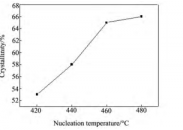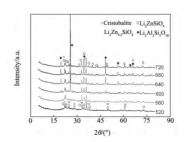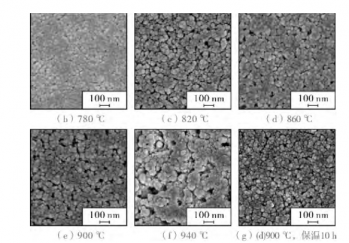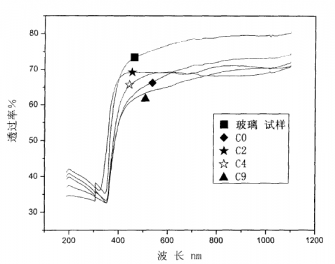透明微晶玻璃组成及制备工艺设计毕业论文
2021-11-26 23:34:09
论文总字数:24687字
摘 要
透明微晶玻璃是一类具有优秀的化学性能、物理性能及热学性能的材料,而且具有较高的可见光透过率,已用于天文望远镜镜片、激光陀螺和液晶显示器面板等领域。微晶玻璃之所以具有如此优秀的性质,主要是因为它的结构比较特别,不仅有晶相也有非晶相。微晶玻璃中,晶相是多样的、晶粒尺寸是多变的及晶相含量是不定的。为了能够获得理想中的晶相、晶粒尺寸及晶相含量,一般都需要通过促进基础玻璃进行成核和晶体长大。在实际微晶玻璃的制备中,主要是通过热处理来实现的。同时,主晶相的种类也取决于微晶玻璃原始组成。不同的主晶相,晶粒尺寸大小不同,与残余玻璃相折射率差值不同,对可见光的透过率也不同。热处理制度对微晶玻璃的可见光通过率、硬度及韧性等性能的影响是主要通过影响微晶体的尺寸和百分含量或者是引起主晶相的种类来实现的。本文通过设计微晶玻璃的组成及制定最佳的热处理制度,并且对以往关于微晶玻璃的热处理制度对析晶行为及性能的影响的文献进行了归纳总结,从而得出了微晶玻璃的组成及热处理制度对透明微晶玻璃性能的影响。
论文主要研究了透明微晶玻璃的组成及热处理制度对微晶玻璃的析晶行为、力学性能、光学性能和热学性能的影响,并且对透明微晶玻璃进行热效应分析、显微结构分析、X射线衍射定性分析、透光率测量、抗折强度测量及热膨胀系数测量。并且通过对以往研究者的研究结果进行归纳总结,探究透明微晶玻璃的组成及热处理制度对微晶玻璃性能的影响。
分析结果表明:在核化温度、核化时间、晶化温度及晶化时间四个热处理因素中,最性能影响最大的是晶化温度。晶化温度不仅可以改变晶粒的大小和百分含量,甚至还会引起主晶相晶型的转变从而改变微晶玻璃的性能。核化温度、核化温度则主要是通过影响微晶玻璃中微晶相的含量来影响微晶玻璃的性能。
本文的特色:通过设计合适的微晶玻璃的组成及热处理制度制备具有优越性能的透明微晶玻璃,然后通过归纳总结的方法来探讨核化温度、核化时间、晶化温度及晶化时间对微晶玻璃性能的影响。
关键词:透明微晶玻璃; 组成设计; 热处理制度
Abstract
Transparent glass-ceramics is an important type of glass-ceramics. Because of its superior physical and chemical properties and high visible light transmittance, it has been used in fields such as astronomical telescope lenses, laser gyros and liquid crystal display panels. Glass-ceramics are a type of polycrystalline material composed of microcrystals and residual glass phases. Different crystal phase types, grain sizes and crystal phase contents will have different properties. The type of crystal phase, crystal grain size and crystal phase content depend on the heat treatment system of glass-ceramics, that is, the nucleation temperature, nucleation time, crystallization temperature and crystallization time. At the same time, the type of main crystal phase also depends on the original composition of glass-ceramics. Different main crystal phases have different grain sizes, different refractive index difference from the residual glass phase, and different transmittance to visible light. The effect of the heat treatment system on the visible light transmittance, hardness and toughness of glass-ceramics is mainly achieved by affecting the size and percentage content of the crystallites or the type of the main crystal phase.
The thesis mainly studies the influence of the composition and heat treatment system of transparent glass-ceramics on the crystallization behavior, mechanical properties, optical properties and thermal properties of glass-ceramics, and the thermal effect analysis, microstructure analysis, X-rays of transparent glass-ceramics Qualitative diffraction analysis, light transmittance measurement, flexural strength measurement and thermal expansion coefficient measurement. And by summarizing the research results of previous researchers, we explored the influence of the composition and heat treatment system of transparent glass-ceramics on the performance of glass-ceramics.
The analysis results show that among the four heat treatment factors of nucleation temperature, nucleation time, crystallization temperature and crystallization time, the most influential performance is the crystallization temperature. The crystallization temperature can not only change the size and percentage content of the crystal grains, but also cause the crystal form of the main crystal phase to change to change the performance of the glass-ceramic. The nucleation temperature and nucleation temperature mainly affect the performance of the glass-ceramics by affecting the content of the crystallite phase in the glass-ceramics.
The characteristics of this article: the transparent glass-ceramics with superior performance are prepared by designing the appropriate composition of the glass-ceramics and the heat treatment system, and then the nucleation temperature, nucleation time, crystallization temperature and crystallization time on the performance of the glass-ceramics are discussed through the method of induction and summary Impact.
Keywords: transparent glass-ceramics; composition; heat treatment system
目录
摘 要 I
Abstract II
目录 IV
第1章 引言 1
1.1 微晶玻璃 2
1.1.1微晶玻璃的定义 2
1.1.2 微晶玻璃的制备方法 2
1.1.3 微晶玻璃的性能及应用 3
1.2 锂铝硅系透明微晶玻璃 4
1.2.1 锂铝硅系透明微晶玻璃的结构 4
1.2.2 LAS系透明微晶玻璃的光学性能 4
1.2.3 LAS系透明微晶玻璃的研究现状 5
第2章 实 验 6
2.1 LAS系透明微晶玻璃的原料 6
2.2 基础玻璃的制备 6
2.3 微晶玻璃的制备 6
2.4 性能测试 7
2.4.1 热效应分析 7
2.4.2 显微结构分析 7
2.4.3 X射线衍射定性分析 7
2.4.4 透光率测量 8
2.4.5 抗折强度测量 8
2.4.6 热膨胀系数测量 8
第3章 LAS系微晶玻璃的组成设计及制备 9
3.1 LAS透明系微晶玻璃的组成设计 9
3.2 LAS系微晶玻璃的制备工艺 10
3.2.1 LAS系微晶玻璃制备方法的选择 10
3.2.2 热处理制度 11
第4章 热处理制度对微晶玻璃性能的影响 13
4.1 热处理制度对微晶玻璃析晶的影响 13
4.2 热处理制度对力学性能的影响 15
4.3 热处理制度光学性能的影响 16
4.4 热处理制度对热学性能的影响 16
第5章 结论 18
参考文献 19
致 谢 21
第1章 引言
目前,大多数微晶玻璃都是单一性质较好。但是随着技术的发展,对微晶玻璃提出了更高的要求。兼具高硬度、高韧性特性的透明微晶玻璃在各行各业都将具有广泛的应用前景,具有良好的社会效益。因此,具有高硬度、高韧性的透明微晶玻璃成为了研究的热点。
微晶玻璃的原始组成是决定微晶玻璃主晶相的主要因素之一。如原始组成为Li2O、A12O3、SiO2的微晶玻璃(LAS系微晶玻璃)在不同的晶化温度下是不一样的。原始组成为MgO、A12O3、SiO2的微晶玻璃(MAS系微晶玻璃)的主晶相一般情况下只有一种,那就是α-堇青石[1]。不同的主晶相尺寸不同,与玻璃体折射率的差值也不同。因此,微晶玻璃的原始组成会对微晶玻璃的可见光透过率产生一定的影响。微晶玻璃的制备工艺中,促使基础进行晶化和核化过程的方法的选择至关重要。热处理制度主要是通过对成核和晶化产生影响进而改变微晶相的尺寸和百分含量以达到改变性能的目的。微晶相的百分含量的多少则会对微晶玻璃的硬度和韧性产生巨大影响。因此,通过设计微晶玻璃的组成和热处理制度是制备高韧性的透明微晶玻璃常用的方法之一。
微晶玻璃是多种多样的,但是被研究人员研究较多的则是铝硅酸盐微晶玻璃。镁铝硅系微晶玻璃和锌铝硅系的主晶相分别为α-堇青石和尖晶石。尖晶石和堇青石常因含有部分别的离子而显现一定的颜色,如在形成尖晶石晶相中存在铁离子时呈现红色红宝石,少量时显橙黄色或橙红色不利于制备透明无色的微晶玻璃[2]。且在热处理过程中晶粒尺寸不易控制,不利于热处理制度的选择。
请支付后下载全文,论文总字数:24687字
相关图片展示:








